Comprehensive Literature Review: Inconel 718 Alloy Characteristics
VerifiedAdded on 2022/10/04
|5
|1107
|17
Literature Review
AI Summary
This literature review provides an overview of Inconel 718, a high-strength, corrosion-resistant nickel-chromium alloy. It discusses the alloy's composition, history, and physical properties, emphasizing its use in extreme environments and high-temperature applications. The review highlights the alloy's resistance to oxidation and corrosion, making it suitable for aerospace, gas turbines, and rocket components. The document also explores the alloy's microstructure, machining, and joining characteristics, citing various research papers to support the findings. It details the alloy's ability to retain strength over a wide temperature range and its importance in various industries. The review also touches on the alloy's manufacturing and fabrication processes, including the challenges of machining the hardened metal. References to key research papers are included to support the information presented.
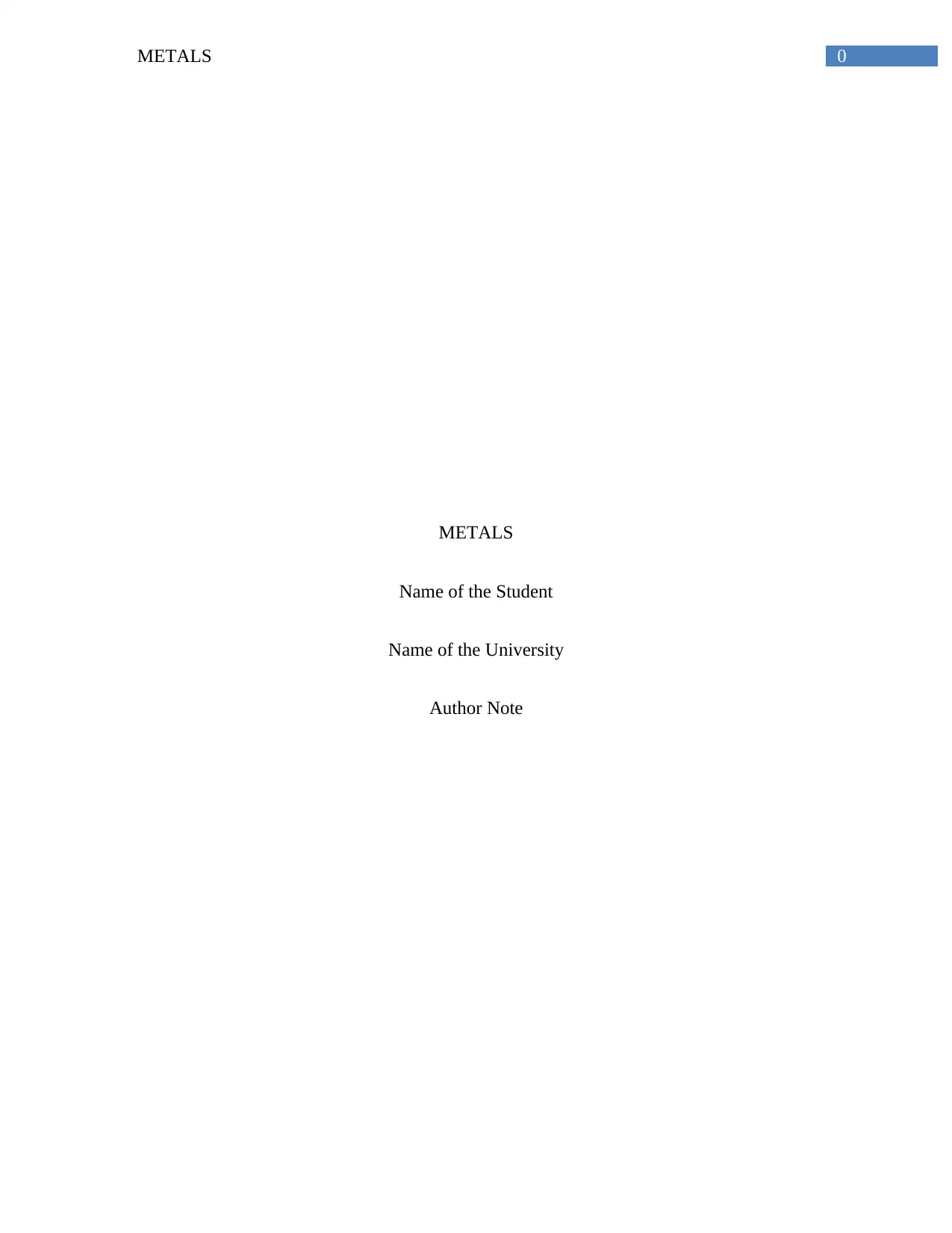
0METALS
METALS
Name of the Student
Name of the University
Author Note
METALS
Name of the Student
Name of the University
Author Note
Paraphrase This Document
Need a fresh take? Get an instant paraphrase of this document with our AI Paraphraser
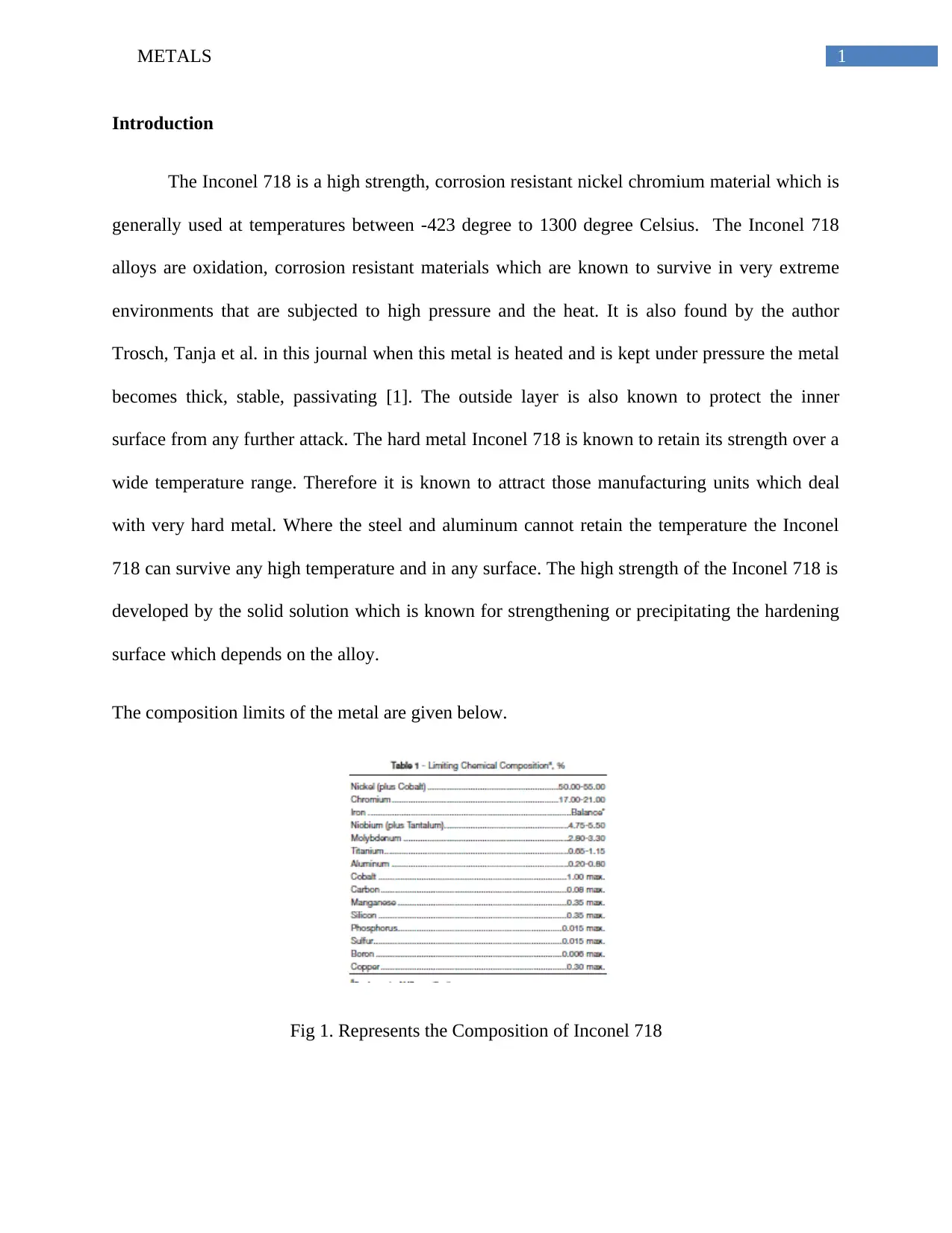
1METALS
Introduction
The Inconel 718 is a high strength, corrosion resistant nickel chromium material which is
generally used at temperatures between -423 degree to 1300 degree Celsius. The Inconel 718
alloys are oxidation, corrosion resistant materials which are known to survive in very extreme
environments that are subjected to high pressure and the heat. It is also found by the author
Trosch, Tanja et al. in this journal when this metal is heated and is kept under pressure the metal
becomes thick, stable, passivating [1]. The outside layer is also known to protect the inner
surface from any further attack. The hard metal Inconel 718 is known to retain its strength over a
wide temperature range. Therefore it is known to attract those manufacturing units which deal
with very hard metal. Where the steel and aluminum cannot retain the temperature the Inconel
718 can survive any high temperature and in any surface. The high strength of the Inconel 718 is
developed by the solid solution which is known for strengthening or precipitating the hardening
surface which depends on the alloy.
The composition limits of the metal are given below.
Fig 1. Represents the Composition of Inconel 718
Introduction
The Inconel 718 is a high strength, corrosion resistant nickel chromium material which is
generally used at temperatures between -423 degree to 1300 degree Celsius. The Inconel 718
alloys are oxidation, corrosion resistant materials which are known to survive in very extreme
environments that are subjected to high pressure and the heat. It is also found by the author
Trosch, Tanja et al. in this journal when this metal is heated and is kept under pressure the metal
becomes thick, stable, passivating [1]. The outside layer is also known to protect the inner
surface from any further attack. The hard metal Inconel 718 is known to retain its strength over a
wide temperature range. Therefore it is known to attract those manufacturing units which deal
with very hard metal. Where the steel and aluminum cannot retain the temperature the Inconel
718 can survive any high temperature and in any surface. The high strength of the Inconel 718 is
developed by the solid solution which is known for strengthening or precipitating the hardening
surface which depends on the alloy.
The composition limits of the metal are given below.
Fig 1. Represents the Composition of Inconel 718
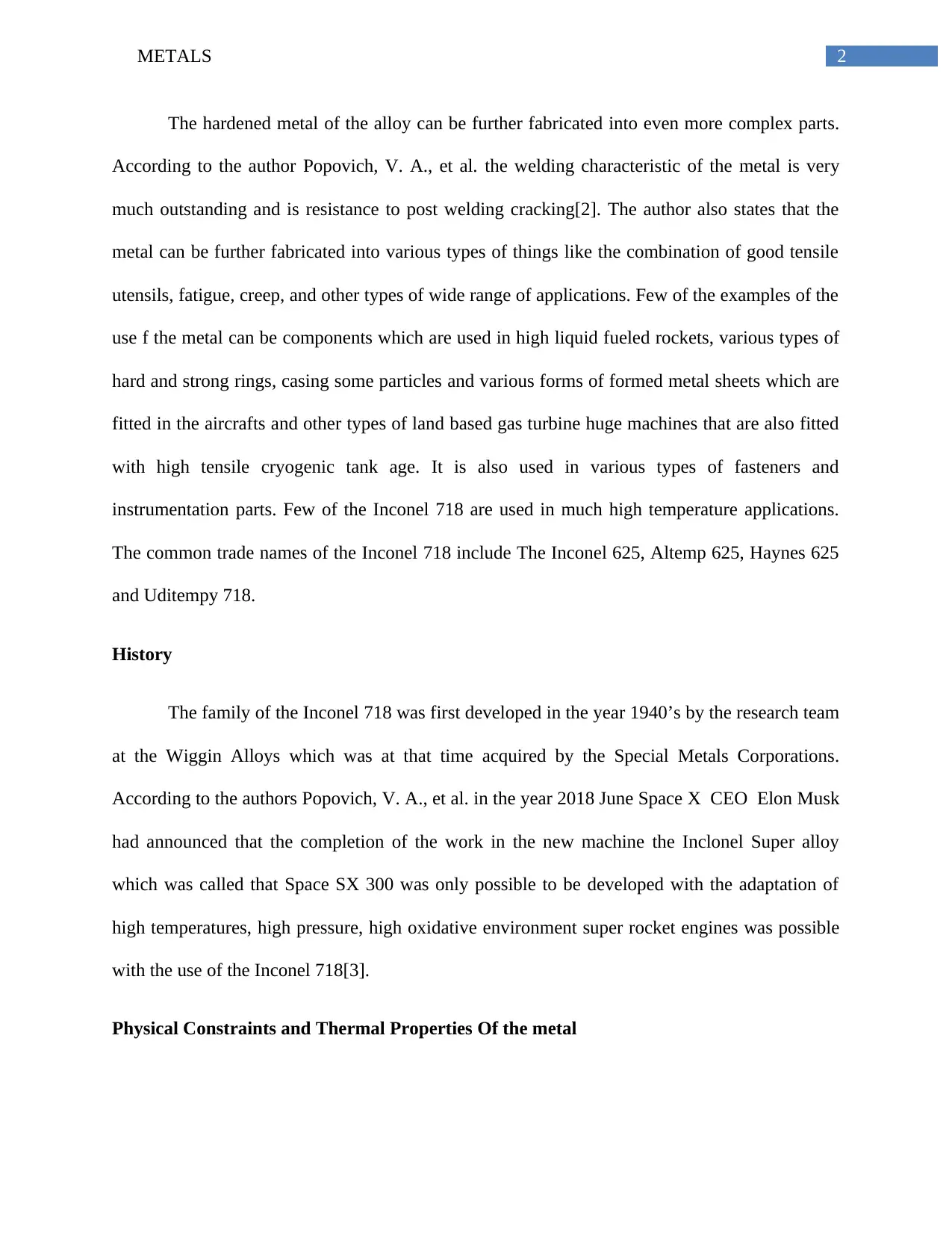
2METALS
The hardened metal of the alloy can be further fabricated into even more complex parts.
According to the author Popovich, V. A., et al. the welding characteristic of the metal is very
much outstanding and is resistance to post welding cracking[2]. The author also states that the
metal can be further fabricated into various types of things like the combination of good tensile
utensils, fatigue, creep, and other types of wide range of applications. Few of the examples of the
use f the metal can be components which are used in high liquid fueled rockets, various types of
hard and strong rings, casing some particles and various forms of formed metal sheets which are
fitted in the aircrafts and other types of land based gas turbine huge machines that are also fitted
with high tensile cryogenic tank age. It is also used in various types of fasteners and
instrumentation parts. Few of the Inconel 718 are used in much high temperature applications.
The common trade names of the Inconel 718 include The Inconel 625, Altemp 625, Haynes 625
and Uditempy 718.
History
The family of the Inconel 718 was first developed in the year 1940’s by the research team
at the Wiggin Alloys which was at that time acquired by the Special Metals Corporations.
According to the authors Popovich, V. A., et al. in the year 2018 June Space X CEO Elon Musk
had announced that the completion of the work in the new machine the Inclonel Super alloy
which was called that Space SX 300 was only possible to be developed with the adaptation of
high temperatures, high pressure, high oxidative environment super rocket engines was possible
with the use of the Inconel 718[3].
Physical Constraints and Thermal Properties Of the metal
The hardened metal of the alloy can be further fabricated into even more complex parts.
According to the author Popovich, V. A., et al. the welding characteristic of the metal is very
much outstanding and is resistance to post welding cracking[2]. The author also states that the
metal can be further fabricated into various types of things like the combination of good tensile
utensils, fatigue, creep, and other types of wide range of applications. Few of the examples of the
use f the metal can be components which are used in high liquid fueled rockets, various types of
hard and strong rings, casing some particles and various forms of formed metal sheets which are
fitted in the aircrafts and other types of land based gas turbine huge machines that are also fitted
with high tensile cryogenic tank age. It is also used in various types of fasteners and
instrumentation parts. Few of the Inconel 718 are used in much high temperature applications.
The common trade names of the Inconel 718 include The Inconel 625, Altemp 625, Haynes 625
and Uditempy 718.
History
The family of the Inconel 718 was first developed in the year 1940’s by the research team
at the Wiggin Alloys which was at that time acquired by the Special Metals Corporations.
According to the authors Popovich, V. A., et al. in the year 2018 June Space X CEO Elon Musk
had announced that the completion of the work in the new machine the Inclonel Super alloy
which was called that Space SX 300 was only possible to be developed with the adaptation of
high temperatures, high pressure, high oxidative environment super rocket engines was possible
with the use of the Inconel 718[3].
Physical Constraints and Thermal Properties Of the metal
⊘ This is a preview!⊘
Do you want full access?
Subscribe today to unlock all pages.

Trusted by 1+ million students worldwide
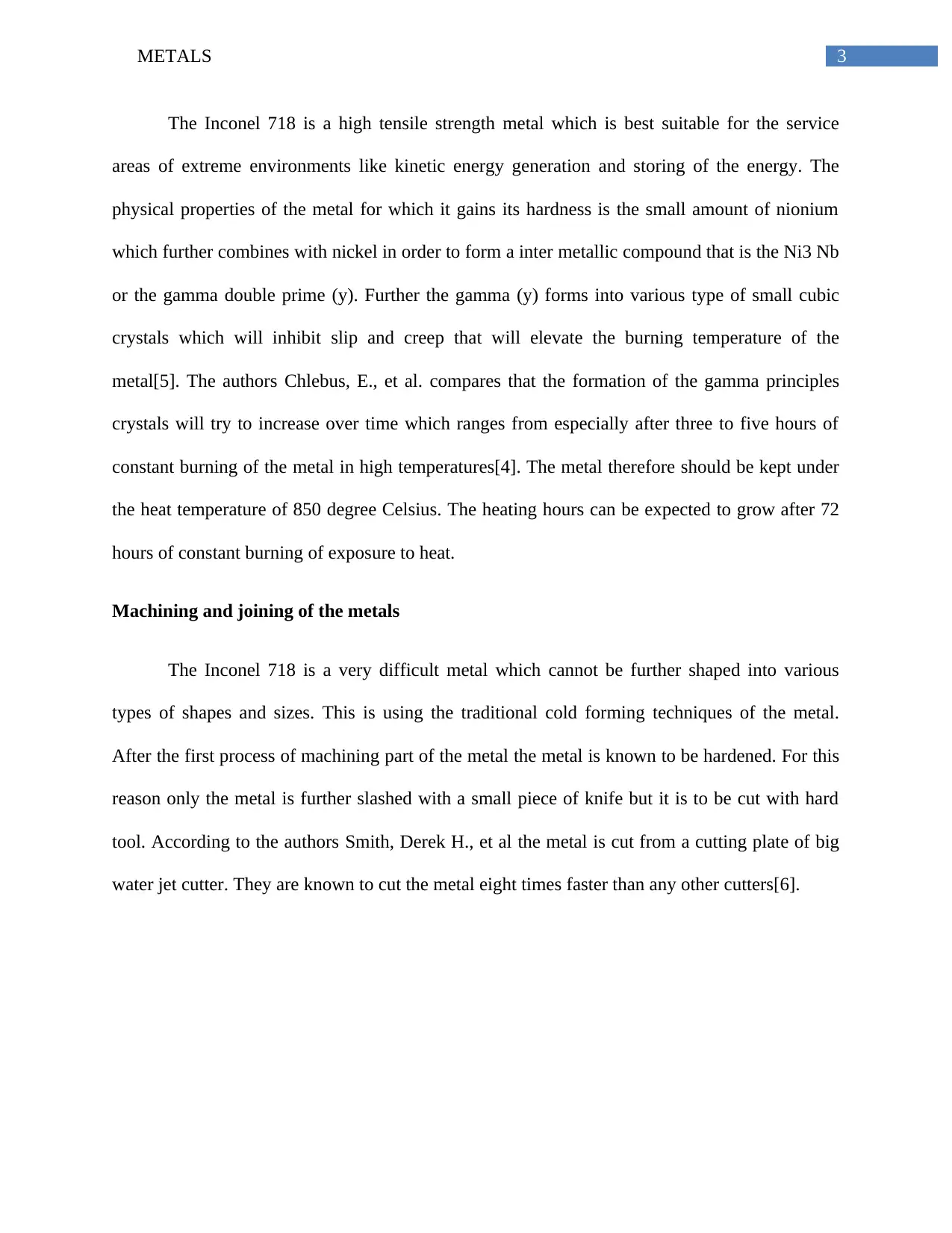
3METALS
The Inconel 718 is a high tensile strength metal which is best suitable for the service
areas of extreme environments like kinetic energy generation and storing of the energy. The
physical properties of the metal for which it gains its hardness is the small amount of nionium
which further combines with nickel in order to form a inter metallic compound that is the Ni3 Nb
or the gamma double prime (y). Further the gamma (y) forms into various type of small cubic
crystals which will inhibit slip and creep that will elevate the burning temperature of the
metal[5]. The authors Chlebus, E., et al. compares that the formation of the gamma principles
crystals will try to increase over time which ranges from especially after three to five hours of
constant burning of the metal in high temperatures[4]. The metal therefore should be kept under
the heat temperature of 850 degree Celsius. The heating hours can be expected to grow after 72
hours of constant burning of exposure to heat.
Machining and joining of the metals
The Inconel 718 is a very difficult metal which cannot be further shaped into various
types of shapes and sizes. This is using the traditional cold forming techniques of the metal.
After the first process of machining part of the metal the metal is known to be hardened. For this
reason only the metal is further slashed with a small piece of knife but it is to be cut with hard
tool. According to the authors Smith, Derek H., et al the metal is cut from a cutting plate of big
water jet cutter. They are known to cut the metal eight times faster than any other cutters[6].
The Inconel 718 is a high tensile strength metal which is best suitable for the service
areas of extreme environments like kinetic energy generation and storing of the energy. The
physical properties of the metal for which it gains its hardness is the small amount of nionium
which further combines with nickel in order to form a inter metallic compound that is the Ni3 Nb
or the gamma double prime (y). Further the gamma (y) forms into various type of small cubic
crystals which will inhibit slip and creep that will elevate the burning temperature of the
metal[5]. The authors Chlebus, E., et al. compares that the formation of the gamma principles
crystals will try to increase over time which ranges from especially after three to five hours of
constant burning of the metal in high temperatures[4]. The metal therefore should be kept under
the heat temperature of 850 degree Celsius. The heating hours can be expected to grow after 72
hours of constant burning of exposure to heat.
Machining and joining of the metals
The Inconel 718 is a very difficult metal which cannot be further shaped into various
types of shapes and sizes. This is using the traditional cold forming techniques of the metal.
After the first process of machining part of the metal the metal is known to be hardened. For this
reason only the metal is further slashed with a small piece of knife but it is to be cut with hard
tool. According to the authors Smith, Derek H., et al the metal is cut from a cutting plate of big
water jet cutter. They are known to cut the metal eight times faster than any other cutters[6].
Paraphrase This Document
Need a fresh take? Get an instant paraphrase of this document with our AI Paraphraser
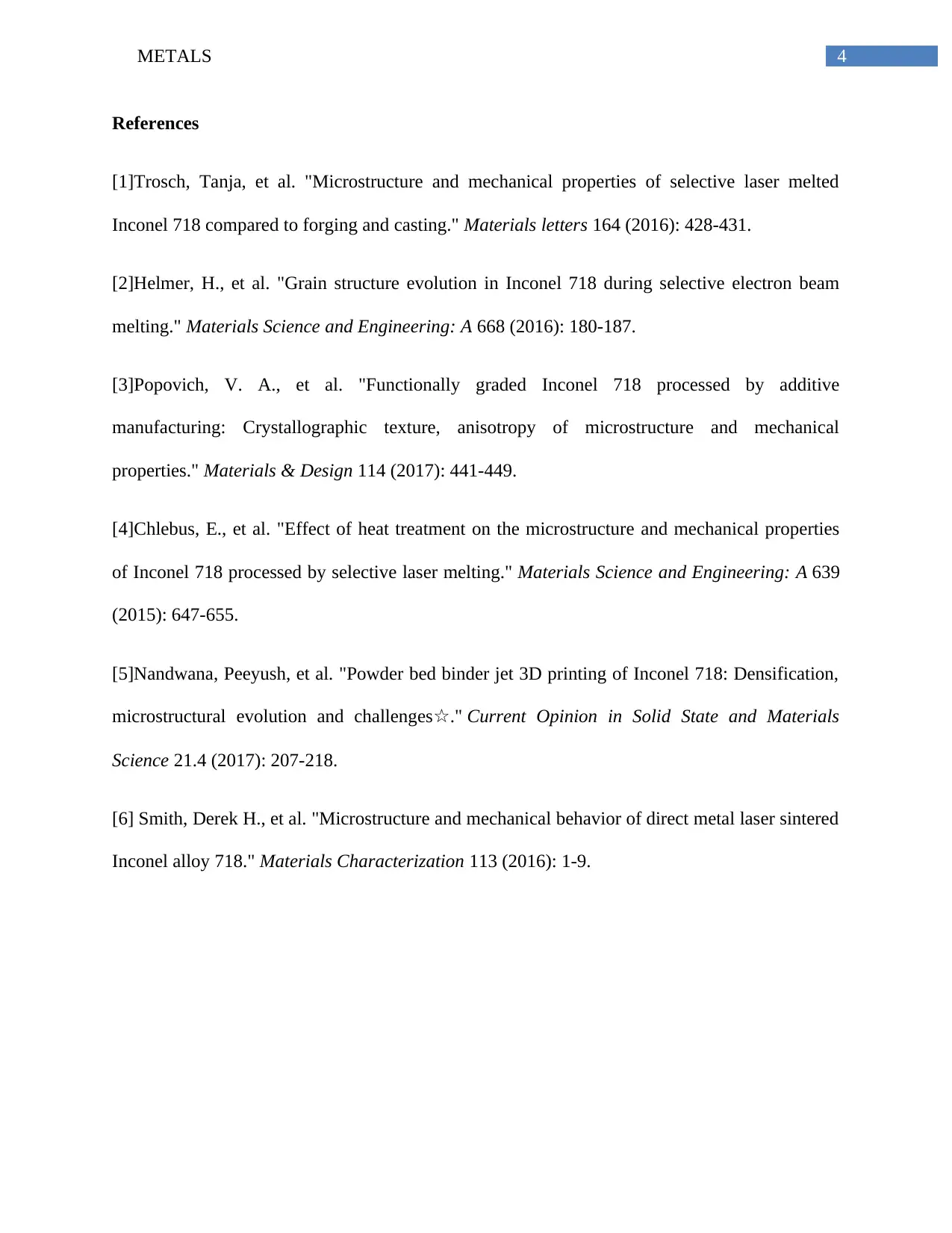
4METALS
References
[1]Trosch, Tanja, et al. "Microstructure and mechanical properties of selective laser melted
Inconel 718 compared to forging and casting." Materials letters 164 (2016): 428-431.
[2]Helmer, H., et al. "Grain structure evolution in Inconel 718 during selective electron beam
melting." Materials Science and Engineering: A 668 (2016): 180-187.
[3]Popovich, V. A., et al. "Functionally graded Inconel 718 processed by additive
manufacturing: Crystallographic texture, anisotropy of microstructure and mechanical
properties." Materials & Design 114 (2017): 441-449.
[4]Chlebus, E., et al. "Effect of heat treatment on the microstructure and mechanical properties
of Inconel 718 processed by selective laser melting." Materials Science and Engineering: A 639
(2015): 647-655.
[5]Nandwana, Peeyush, et al. "Powder bed binder jet 3D printing of Inconel 718: Densification,
microstructural evolution and challenges☆." Current Opinion in Solid State and Materials
Science 21.4 (2017): 207-218.
[6] Smith, Derek H., et al. "Microstructure and mechanical behavior of direct metal laser sintered
Inconel alloy 718." Materials Characterization 113 (2016): 1-9.
References
[1]Trosch, Tanja, et al. "Microstructure and mechanical properties of selective laser melted
Inconel 718 compared to forging and casting." Materials letters 164 (2016): 428-431.
[2]Helmer, H., et al. "Grain structure evolution in Inconel 718 during selective electron beam
melting." Materials Science and Engineering: A 668 (2016): 180-187.
[3]Popovich, V. A., et al. "Functionally graded Inconel 718 processed by additive
manufacturing: Crystallographic texture, anisotropy of microstructure and mechanical
properties." Materials & Design 114 (2017): 441-449.
[4]Chlebus, E., et al. "Effect of heat treatment on the microstructure and mechanical properties
of Inconel 718 processed by selective laser melting." Materials Science and Engineering: A 639
(2015): 647-655.
[5]Nandwana, Peeyush, et al. "Powder bed binder jet 3D printing of Inconel 718: Densification,
microstructural evolution and challenges☆." Current Opinion in Solid State and Materials
Science 21.4 (2017): 207-218.
[6] Smith, Derek H., et al. "Microstructure and mechanical behavior of direct metal laser sintered
Inconel alloy 718." Materials Characterization 113 (2016): 1-9.
1 out of 5
Related Documents
Your All-in-One AI-Powered Toolkit for Academic Success.
+13062052269
info@desklib.com
Available 24*7 on WhatsApp / Email
![[object Object]](/_next/static/media/star-bottom.7253800d.svg)
Unlock your academic potential
Copyright © 2020–2025 A2Z Services. All Rights Reserved. Developed and managed by ZUCOL.



